
When Ruger released the SR-556 as their entrance into the very dynamic “Modern Sporting Rifle” market, it was obvious they had no intention of going in cheap, as defined by price or quality and design of equipment. Not only is the SR-556 a standout in regards to features like the gun’s gas operated, piston driven actuation system, but it is also a standout because of the inclusion of popular, high end, third party components… like Troy Industries BattleRails™, Folding BattleSights™ and hand protecting Picatinny RailGuards™.
Accessories are ever changing in the world of the AR, as are the names of the companies perceived to have the best ideas. With the SR-556’s modular approach, Ruger is able to concentrate on producing the best core firearm and associated performance, while still providing customers with the best and newest accessories.
For those fond of box scores…
|
Ruger SR-556 |
|
| Manufacturer | Sturm, Ruger & Co. |
| Model | SR-556/6.8 #5909 |
| Finish | Manganese Phosphate/Hard coat Anodized |
| Stock | Poly – Collapsible |
| Handguard | Floating – Multiple Picatinny rails |
| Action | Gas Operated, Piston Driven Autoloader |
| Caliber | 6.8 Remington SPC |
| Magazine Capacity | 5 & 25 Rounds |
| Barrel Length | 16.1″ |
| Rifling | 1:10″ RH 6 Groove |
| Overall Length | 32¾” Collapsed – 36″ Extended |
| Length of Pull | 10¼” – 13½” |
| Trigger Pull | 8 lbs 3 oz |
| Weight – W/O Mag | 7 lbs 11 oz |
| MSRP – Rifle and Kit | $1,995 |
| Discount Retail | $1,500 |
RealGuns prior coverage of the 5.56 NATO version of the rifle can be found at “Ruger’s SR-556 -What comes after an AR-15?“.
This version of the SR-556 is the same rifle in form, fit and function, only adapted to the 6.8 Remington SPC (0.277″) cartridge. There are six parts that differentiate the two models: Barrel Assembly, Regulator, Crush Washer, Flash Suppressor, Bolt, and Extractor. All items accommodate either the physical size or gas volume / pressure of the two cartridges. The 6.8 SPC version has a slightly slower rate of rifling twist.
A few points to consider…

The Ruger SR-556 as received is ready to go. Differing slightly from the SR-556 5.56 NATO version pictured above, the 6.8 SPC version Ruger retail carton contained two twenty five and one five round magazines. Both models include the soft case and rail covers.
External look and operating overview…
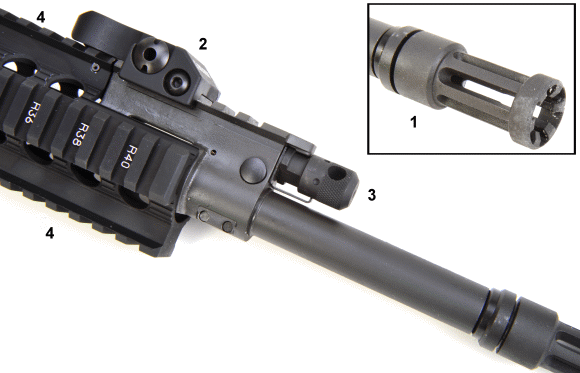
The flash suppressor (1) ahead of a peel washer is pretty much standard fare and the same as the flash suppressor on the current Mini-14 Tactical. The front sight mounted above the gas block (2), is a Troy Industries adjustable folding battle sight with HK Globe type brush guards. The gas regulator and gas block (3), is an all steel assembly with four indexed settings to adapt the gun to various types of shooting and ammunition. “0” position blocks all gas from entering the system and renders the SR-556 a single shot that must be manually cycled, Positions 1 through 3 allow progressively more gas flow with position 2 being the typical for factory ammunition.
Folding battle sights…

The Troy Industry sights are a good selection. Easy to install and remove using the gun’s Picatinny rail system. They are very solid. Popped up for use, the front sight offers elevation adjustment in 1 MOA click increments, the rear sight provides 1/3 MOA incremental windage adjustment. Both sights fold to a compact 1/2″ height to place them out of the way of additional optical or electronic sighting systems that might be installed by those of us with 5 MOA eyesight.
A rail…y good way to mount stuff
 The hard anodized and Teflon coated aluminum floating handguard (4), incorporates four Picatinny rails – 3, 6, 9, and 12 o’clock positions, each location marked with white alphanumeric identifiers to assist when installing and reinstalling optics and other accessories.
The hard anodized and Teflon coated aluminum floating handguard (4), incorporates four Picatinny rails – 3, 6, 9, and 12 o’clock positions, each location marked with white alphanumeric identifiers to assist when installing and reinstalling optics and other accessories.
The top rail blends into the Picatinny rail that is integral to the gun’s receiver; the top rail runs the length of the gun. A set of rail covers are supplied for three sides to provide a comfortable handhold when accessories are not installed at these sections of rail.
The layout of controls and placement of locating pins are all AR standard, so upgrade and newly developed bits, pieces and accessories can be added as the gun’s owner desires. As an example, an oversize cold weather trigger guard, a cushy palm swell grip, other standard AR magazines, and stocks suitable for differing applications can easily be installed. The exception to universal parts fit would be the gun’s handguard which is made to clear the Ruger’s adjustable gas block and to allow passage for the transfer rod and spring assembly that replaces the gas tube found on a conventional gas operated AR. This is also a factory fit part and not intended for customer removal. As the SR-556’s handguard is of a very current and popular configuration, I couldn’t see the need to make a change to this part in the foreseeable future. Ruger also offers a complete 6.8 Remington SPC upper receiver assembly that customers can use to switch calibers if they own a small bore SR-556 or they can match it up with any of their favorite non-Ruger AR15 standard lower receiver assemblies.
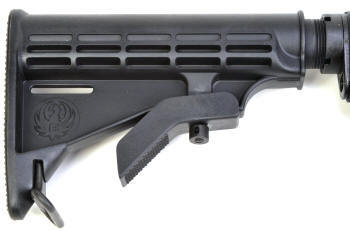
The Ruger has a well made collapsible stock that is adjusted by pushing up on the lower lever. Lock up is positive, the stock feels stable in use and the shooter may select one of six positions. As an old Air Force vet, I have no idea how to shoot the gun with the stock in any position other than fully extended
The buttstock includes a sling swivel, the handguard does not, however accessory sling swivels that attach to a Picatinny rail are easy to come by. Brownells offers a large selection of this type of hardware at very reasonable prices.
Maintenance takedown…
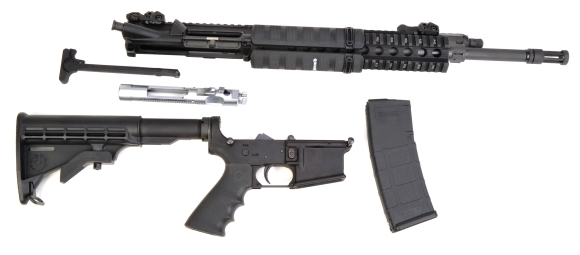
Take down for routine cleaning and maintenance is easy. Pull out the charging handle, cock the hammer and rotate the safety to the “safe” position. The rear takedown pin is pushed out to the detent, I used a Delrin AR15 take down tool, then the upper assembly can be tipped down and the bolt carrier and charging handle can be removed. Push out the forward pivot pin, left to right just like the takedown pin, and the upper receiver can be removed from the lower.
The center of the SR-556 universe…
Conventional AR-15 type firearms have a gas block fixed some inches aft of the firearm’s muzzle, over an open orifice drilled in the gun’s barrel. A hollow tube runs from the gas block down the length of the barrel, under the cover of the gun’s handguard, through the face of the receiver and into the tubular receptacle of the bolt carrier key that sits atop the bolt carrier. When the firearm is discharged, gas is bled off from the barrel into the gas block, then into the gas tube and down to the bolt carrier key where pressure forces the bolt carrier open and cycles the gun. The gas is hot and contains powder residue which, combined, pumps miniscule debris into the gun’s receiver and elevates operating temperature. Additionally, on conventional ARs the gas flow is of fixed regulation and may be sensitive to ammunition power levels – lower pressure ammo may cause a failure to cycle and higher than standard pressure may promote excessive wear. The SR-556 gas operated piston system addresses both issues.

The Ruger SR-556 system utilizes a gas block with a barrel connecting orifice that permits gas to flow from the barrel to the block. However, instead of flowing directly into a tube and being carried to the bolt carrier, gas first flows through a metering body, a regulator, that offers four shooter selectable levels of flow. Labeled “Variable size gas ports” in the photo above, a smaller port is selected for higher pressure loads or to set the gun to single shot, manual cycle. Progressively larger ports are selected as ammunition load pressure diminishes. The parts are shown disassembled for the purpose of illustration as finger tip adjustments are made with the assembly installed, as pictured in inset. Maintenance of the Ruger assembly is easy to accomplish; the regular pin, #4 in the picture above, is pushed left to right to the detent position, the regulator is indexed to the gas block flat and the parts pull out with light finger pressure.
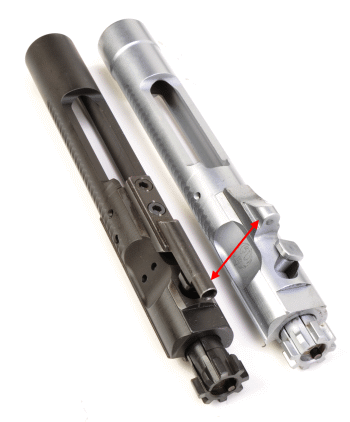 Another major feature of the SR-556 operating system is labeled #3 in the photo above, the piston that replaces the function of the AR standard gas tube. With the Ruger system, gas from the regulator acts on the piston and the piston drives a transfer rod that mechanically acts on the bolt carrier. Photo left illustrates the difference between a bolt carrier key to contain a gas tube versus the Ruger where a bushing driven by a transfer rod actuates the bolt carrier. The SR-556 system runs cooler during extended fire and there is no more powder residue passed to the bolt carrier through the gas tube.
Another major feature of the SR-556 operating system is labeled #3 in the photo above, the piston that replaces the function of the AR standard gas tube. With the Ruger system, gas from the regulator acts on the piston and the piston drives a transfer rod that mechanically acts on the bolt carrier. Photo left illustrates the difference between a bolt carrier key to contain a gas tube versus the Ruger where a bushing driven by a transfer rod actuates the bolt carrier. The SR-556 system runs cooler during extended fire and there is no more powder residue passed to the bolt carrier through the gas tube.
After a lot of SR-556 shooting, both cartridges, with both factory and handloaded ammo, I’ve found the gun to be highly reliable, it does run a lot cooler in heavy use and it is easy to maintain. The latter not a small point as I am incredibly lazy and I do not take joy in cleaning firearms. I do it, but I don’t like it. As a handloader, the adjustable gas bleed is greatly appreciated.
Control is where you find it… and where it is expected
If you are an AR shooter, your fingers and hand motion will find all of the controls as they have been conditioned to expect. Actuation of controls is crisp and positive; everything thunks, pops and slaps as they should. The finish did not rub off under controls at contact surfaces. The trigger pull is… more than casual, but who wants a hair trigger on an AR?

After some shooting time, the Ruger was easy to shoot with the stock pulled full out and easy to carry with the stock pushed in. The six adjustment lengths made it easy to adapt to clothing and method of carry. The forearm with rail covers in place made for a very comfortable hold. The metallic sights were a little low for me, just like its AR-15 brothers. With a scope on medium height mounts, eye alignment was very comfortable.
On to the real fun…
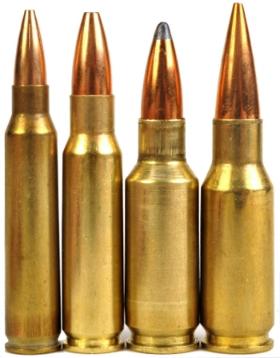
L-R, 5.56 NATO, 6.8 Remington SPC, the Real Guns 7mm-30 RG wildcat, and the 30 Remington AR. All of these work well with the AR platform. Higher pressure limits of single shot and bolt action firearms allow them to be even better.
The story here is the 6.8 Remington SPC in concert with an excellent SR-556. I encourage you to read the original coverage of the SR-556 as Part II is headed toward live fire and handload assessment. The 6.8 SPC is a long case in a caliber that typically requires long bullets. Consequently, bullets intended for this specific application, like the 110 and 120 grain Hornady and Remington bullets, have a short ogive to assure there is plenty of parallel shank to anchor the bullet in the case. A different approach is the short stubby case to allow for longer bullets in the same allowable 2.260″ COL. The 0.277″ bullet was selected by Special Forces saw this cartridge as the ideal balance of bullet weight and exterior ballistics and the stubbies are usually larger in caliber. So the results of Part II should be interesting.

Email Notification